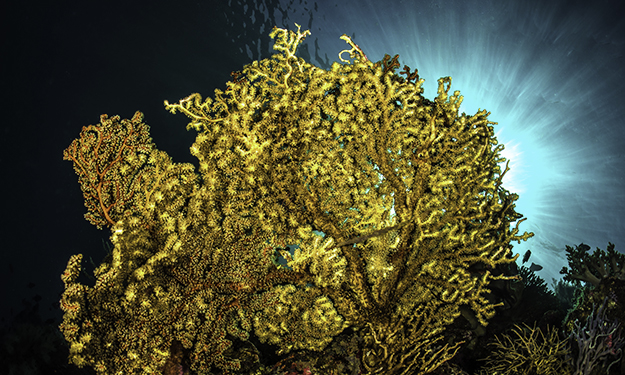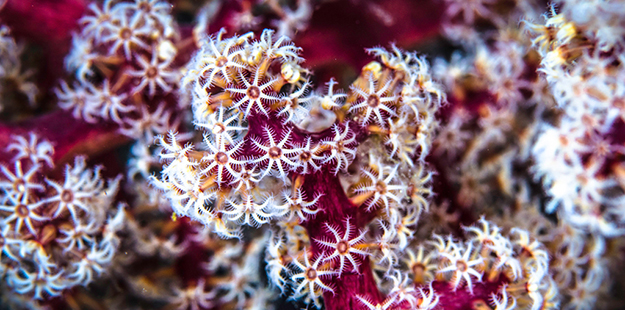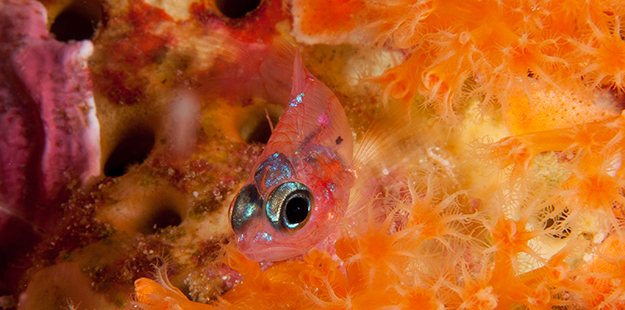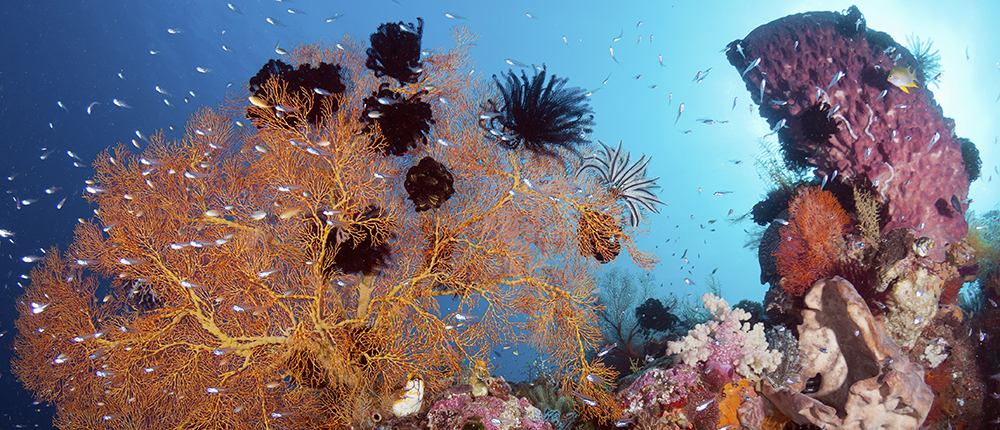Fan Favorites
Discovering the Hidden Life Within Wakatobi’s Sea Fans
If you imagine the reefs at Wakatobi Resort as coral jungles, it is the sea fans that become the trees. Yes, they are technically animals—more on that later—but in many respects, the prolific growths of sea fans that cover the walls and slopes of many of our dive sites are the underwater equivalent of a forest. They stand rooted in place, grow slowly, deploy branch-like structures, add color and interest to the landscape, and provide shelter and habitat for a variety of animals. And much like trees, sea fans are often taken for granted by divers as they scan their surroundings for interesting subjects. Take a closer look, however, and you may discover a wealth of hidden treasures among the branches.

Sea fans that are pure filter feeders typically display vivid hues of purple, red, pink, and orange to rich yellows and gold. Photo by Wayne MacWilliams
Fan facts
Scientists have decided that sea fans and sea whips are part of an order now known as Alcyonacea, but most reference sources still call them gorgonians, so we’ll stick to the traditional classification. Like all corals and anemones, gorgonians are animals, but they don’t move about. Instead, they let the food come to them, and some grow gardens to supplement their diet. In slightly more technical terms, they are a colonial assembly of individual polyps held together by a flexible substrate made of gorgonian proteins. Each polyp deploys eight stinging tentacles known as nematocysts to stun and capture prey, which is then pulled into the gastrovascular cavity. Each individual polyp within the sea fan’s communal structure hunts and feeds for itself, but they do have ways to transfer nutrients back and forth, in essence sharing the kill.

Sea fan polyps are held together by a flexible substrate made of gorgonian proteins. Each polyp deploys eight stinging tentacles known as nematocysts to stun and capture prey. Photo by Wayne MacWilliams
Some sea fans also cultivate symbiotic zooxanthellae algae as a food source, and you can usually tell which ones that are hosting algae by their brownish-green colors. Also, they tend to grow shallow and on more horizontal reef structures where there is abundant sunlight.
There are 100-year-old sea fans on Wakatobi reefs, and it’s been speculated that a colony could survive for centuries under ideal conditions.
The pure filter feeders, by contrast, display vivid hues of purple, red, pink, and orange to rich yellows and gold. They thrive on walls, and at much greater depths. In the shallows, fans tend to be smaller and more flexible to withstand tidal and storm surges, while the taller, thinner, and stiffer branched relatives typically dwell in deeper, calmer waters.

Not all sea fans are flat; some are bushy like this red cherry blossom gorgonian on the wall at Turkey Beach. Photo by Walt Stearns
Walls around Wakatobi Resort are adorned with a variety of large sea fans that can grow to spans of 2 to 4 meters in diameter. Size matters, because the bigger the fan, the more it can eat. Unlike hard corals, which extend polyps primarily at night, sea fans feed whenever there is moving water. They are slow growing, and can take decades to reach a good size. Scientists aren’t sure how long a sea fan might live if undisturbed by storms, disease or predators such as the Flamingo Tongue Snail. We do know that there are 100-year-old sea fans on Wakatobi reefs, and it’s been speculated that a colony could survive for centuries under ideal conditions—making it all the more important for divers not to disturb sea fans with errant fin kicks.
Among the branches
Much like a forest tree, a large sea fan is often home to a long list of animal life, from flamboyant, flower-like crinoids to the tiniest of fish and invertebrates. The most obvious residents of a sea fan are fellow filter feeders such as sea stars, brittle stars and sea lilies, also known as crinoids. Like the iconic starfish, these members of the Echinoderm phylum sport five appendages, though they sometimes seem to have little else in common. Brittle stars and sea stars may be seen crawling across the branches of a sea fan, slurping up a bit of algae and any small animals or stray bits of organic matter they come across. More photogenic are the brightly-colored crinoids such as the feather stars, which can often be found perched on the outer edge of a sea fan, stretching their tentacles into the current to get first dibs at any passing morsel.

The longnose hawkfish likes to rest on the branches or in the midst of a sea fan typically seeking the high ground from where they can survey their surroundings. Photo by Frank Owens

The tiny ghost goby has a semi-transparent body that mimics the color of their host sea fan. Photo by Allen Saban
Look a bit closer among the branches and you will discover a variety of small fish. One of the more notable and photogenic residents is the longnose hawkfish. Typically 5 to 10 cm in length, they have a predominantly white body with pronounced red to orange striping, running both horizontally and vertically. As colorful as they are they can also be difficult to find as they are not very conspicuous against a sea fan of like color. The longnose hawkfish likes to rest on the branches or in the midst of a sea fan typically seeking the high ground from where they can survey their surroundings. Perched from a good vantage point like their namesake hawk on an outstretched tree branch, they can dart out to grab small crustaceans or other invertebrates, as well as fish swimming by. Sadly, one of their favored meals is another resident of the sea fan: the pygmy seahorse, which they have an easier time finding when one is highlighted by a diver’s camera strobe or hand held light. A smaller and more elusive finned resident is the ghost goby. Not only are they small, growing to just 3 cm, they have semi-transparent bodies, and the parts that do show often mimic the coloration of their host fan.


